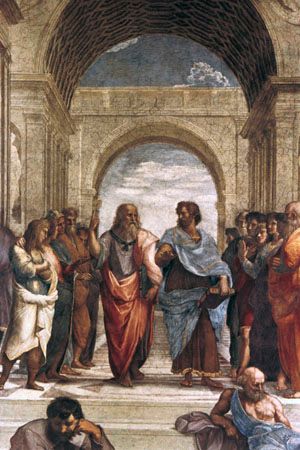idea
- Key People:
- Socrates
- Aristotle
- John Locke
- David Hume
- Philo Judaeus
- Related Topics:
- innate idea
- abstraction
- generalization
- concept
- idée reçue
idea, active, determining principle of a thing. The word, brought into English from the Greek eidos, was for some time most commonly used roughly in the technical sense given to it by Plato in his theory of forms. By the 17th century it had come to be used more or less in its modern sense of “thought,” “concept,” “belief,” “intention,” or “plan.”
In the 17th and 18th centuries, the word “idea” was in very general use as a technical term of philosophy, not with its Platonic meaning, but in a variety of senses mostly traceable to John Locke, some of which were derived by him from René Descartes. In his An Essay Concerning Human Understanding, Locke introduces it first as “that term which, I think, serves best to stand for whatsoever is the object of the understanding when a man thinks” and later as signifying “the immediate object of perception, thought, or understanding.” This vague usage leads him into serious difficulties. In the first place, he holds that ideas are “in the mind”; so that, if ideas are said to be the objects of perception, he is faced with the problem of explaining how perception could lead to knowledge of the “external” world. Secondly, he is led to overlook the important respects in which thinking and understanding must be distinguished from perception: he speaks indeed as if thinking and understanding really are essentially forms of perception, or as if all three consisted alike in “having ideas.”
George Berkeley retained the word “idea,” for which he sometimes used “sensation” as a synonym, to stand for the objects of perception. He retained the view that ideas are “in the mind,” and he sought to evade the problem which Locke had failed to solve—the problem of basing knowledge of the material world on perception of mind-dependent ideas—by refusing to draw any distinction between ideas and material objects. Material objects, he held, are “collections” of ideas, and hence they too can exist “only in the mind.”

David Hume introduced a distinction between ideas and impressions—the latter term being designed to cover “all our sensations, passions, and emotions,” the former “the faint images of these in thinking and reasoning.” In so doing, however, he did not much improve upon Locke: he still held that the objects of perception are “in the mind” and for the most part he retained in his account of thinking the fatally misleading analogy with perception. It was urged by an early critic, Thomas Reid, that most of the perplexities in which Locke, Berkeley, and Hume had been entangled arose from initial confusions in the use of the word “idea,” for which Reid thought Descartes ultimately responsible. Even though it can hardly be adequate to trace all difficulties to this one source, it can be said that their uses of the term “idea” require very close and critical scrutiny, if their problems are to be resolved or even rightly understood.
















